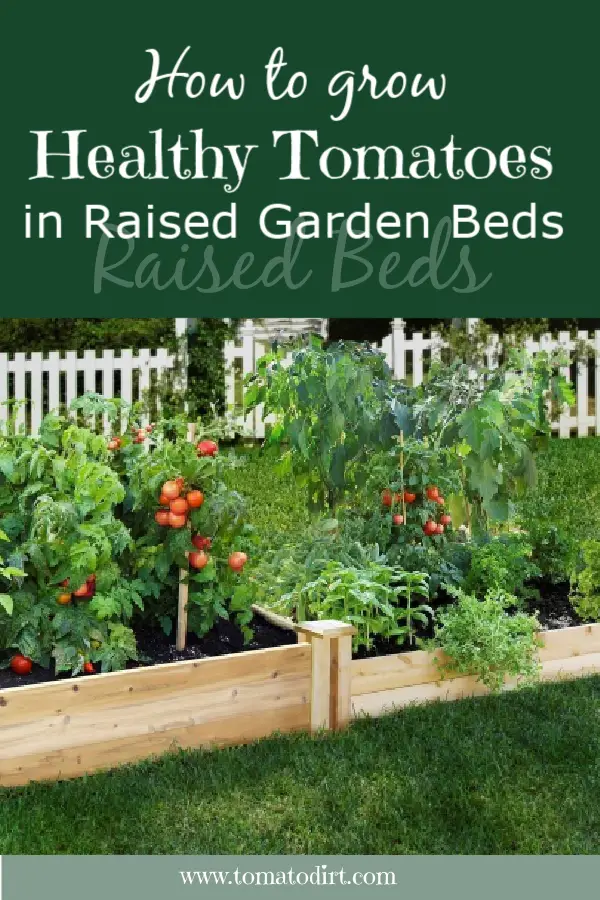FREE: 10 Must-Know Tomato Growing Tips Get The Guide
Read our affiliate disclosure here.
6 Tips for Growing Tomatoes In Raised Garden Beds
Since 2010, Tomato Dirt has garnered 4.6+ million views, making it the web’s leading online source for growing tomatoes in the home garden. Award-winning writer and Tomato Dirt owner Kathy Widenhouse has helped thousands of home gardeners grow healthier tomatoes. Be one of them when you get Tomato Dirt’s Growing Guide here.
Updated 3.6.24
Raised garden beds are an excellent way to grow tomatoes. In raised beds, tomatoes are easier to manage than in a full garden since most raised beds are smaller than an entire plot. That makes raised garden beds a perfect way for new gardeners to get started and a fun option to try when you’re gardening with kids. Plus, raised beds can give you healthy crops and an outstanding yield.
Once you set up your beds, you can save time and work in preparing to plant during subsequent seasons. Instead of tilling the soil, you simply add organic matter and fertilizer. Plants get better drainage than most open garden plots which limits the spread of diseases.
Be aware of these special tips for growing tomatoes in raised garden beds so you can grow healthy crops and maximize your harvest year after year.
6 Tips for Growing Tomatoes In Raised Garden Beds
Tip 1. Amend the soil every year
Soil is the key ingredient to successful raised garden beds. One of the benefits to using raised beds is that you can control the soil conditions – especially important when growing tomatoes, since they are heavy feeders.
If you’re building a new raised bed, be sure you remove the top sod. You can use the soil beneath the bed but be sure to turn it with a spade and amend it. Work in several inches of top soil and organic matter (shredded leaves, compost, well-rotted manure, kelp) to create a healthy home for your tomato plants. Each year, when you replant, add a couple of inches of additional organic matter to the soil.
Tip 2. Rotate crops every year
If you grow other crops in addition to tomatoes in your raised garden beds, rotate where you plant them each year. Different kinds of crops deplete different nutrients in the soil. Rotating helps restore the nutrients to the soil in different areas of the bed. Legumes, like peas or beans, are a good crop to rotate with tomatoes because they restore nitrogen to the soil. Nitrogen is a key nutrient in growing healthy tomato plants.
Rotating crops also helps prevent diseases in your garden. Early blight and late blight affect tomatoes. Those fungi can overwinter in the soil. But blight does not impact legumes, so by rotating crops you can eliminate or reduce blight in this year’s crop.
Tip 3. Space plants
Set up your raised bed so that you can reach the center of the plot from either side. Ideally, that’s about four feet wide, allowing you to reach two feet into the center of the bed.
Do that and you can plant one tomato for each square foot of garden space. That means if your raised bed is four feet by four feet, you can plant 16 tomato plants. In the garden, you’ll allow more space in between plants. In a raised bed, you can get away with more concentrated planting as long as you …
Tip 4. Stake early
If you wait to add cages or supports to your tomato plants – especially those in raised beds – then you risk damaging the root system when you finally get around to inserting stakes. Instead, stake your plants soon after you place them in the raised bed.
Tip 5. Prune often
Closely-planted tomatoes need to be pruned in order to keep plants tidy and under control. When you prune tomatoes in raised garden beds, you also help stimulate larger fruit because plants pour their energy into the crop rather than maintaining more suckers and leaves. Pruned tomatoes in raised garden beds also reduce disease, especially when you …
Tip 6. Water from below
Tomatoes do best when watered slowly and deeply. As water sinks down lower into the soil, the tomato’s roots must follow suit and reach down further to absorb it. Deep watering helps tomato plants build strong root systems.
If possible, set up a drip watering system for your tomato plants. Drip hoses get water directly to the plant’s roots. This means the water will evaporate less during the heat of the summer. Drip watering also prevents spray onto the plant stems, leaves, and fruit, thereby reducing the spread of tomato diseases. You can set your soaker hose system on a timer to water plants if you’re busy. Or you can turn on the drip hoses while you’re working in the garden and save time that you’d otherwise use holding the hose and nozzle.
More about growing tomatoes in raised garden beds
7 Benefits of Raised Beds for Gardening ...
8 Guidelines for Growing Raised Bed Tomatoes ...
Raised Beds for Tomatoes: the basics you need to know ...
Starting a Raised Bed Vegetable Garden FAQs ...
Materials for Your Raised Garden Bed: a primer ...
Preparing Your Soil to Grow Tomatoes and Vegetables ...
Raised Bed Gardening ideas on our Pinterest board ...
Return from Tips for Growing Tomatoes In Raised Garden Beds to Tomato Dirt home
As an Amazon Associate and Rakuten Advertising affiliate I earn from qualifying purchases.
SHARE THIS PAGE:
FREE! 10 Must-Know Tomato Growing Tips: 20-page guide
Get yours here:




